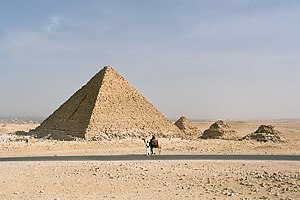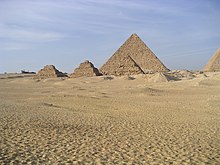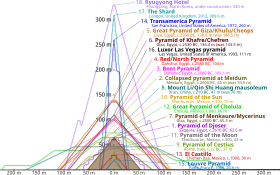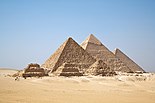
The Great Pyramid of Giza is the largest Egyptian pyramid. It served as the tomb of pharaoh Khufu, who ruled during the Fourth Dynasty of the Old Kingdom. Built c. 2600 BC, over a period of about 27 years, the pyramid is the oldest of the Seven Wonders of the Ancient World, and the only wonder that has remained largely intact. It is the most famous monument of the Giza pyramid complex, which is part of the UNESCO World Heritage Site "Memphis and its Necropolis". It is situated at the northeastern end of the line of the three main pyramids at Giza.

The pyramid of Djoser, sometimes called the Step Pyramid of Djoser, is an archaeological site in the Saqqara necropolis, Egypt, northwest of the ruins of Memphis. It is the first pyramid to be built. The 6-tier, 4-sided structure is the earliest colossal stone building in Egypt. It was built in the 27th century BC during the Third Dynasty for the burial of Pharaoh Djoser. The pyramid is the central feature of a vast mortuary complex in an enormous courtyard surrounded by ceremonial structures and decoration.

Khafre or Khafra, also known as Khephren or Chephren, was an ancient Egyptian pharaoh of the Fourth Dynasty during the Old Kingdom. He was the son of Khufu and the successor of Djedefre.

The Egyptian pyramids are ancient masonry structures located in Egypt. Sources cite at least 118 identified "Egyptian" pyramids. Approximately 80 pyramids were built within the Kingdom of Kush, now located in the modern country of Sudan. Of those located in modern Egypt, most were built as tombs for the country's pharaohs and their consorts during the Old and Middle Kingdom periods.
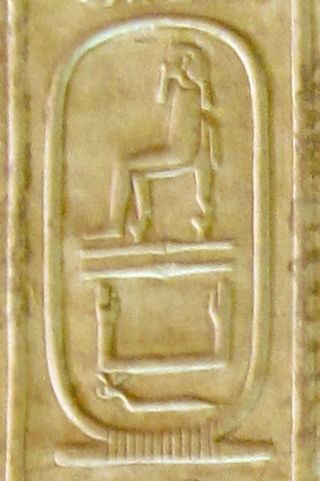
Shepseskaf was a pharaoh of ancient Egypt, the sixth and probably last ruler of the fourth dynasty during the Old Kingdom period. He reigned most probably for four but possibly up to seven years in the late 26th to mid-25th century BC.
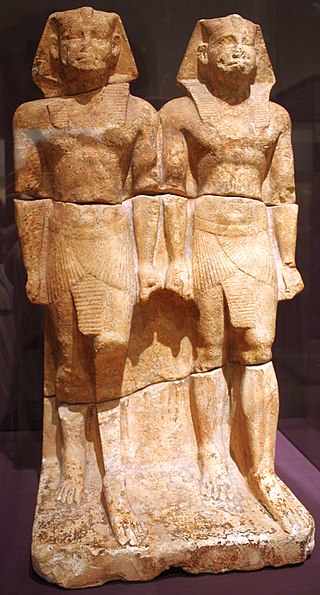
Nyuserre Ini was an Ancient Egyptian pharaoh, the sixth ruler of the Fifth Dynasty during the Old Kingdom period. He is credited with a reign of 24 to 35 years depending on the scholar, and likely lived in the second half of the 25th century BCE. Nyuserre was the younger son of Neferirkare Kakai and queen Khentkaus II, and the brother of the short-lived king Neferefre. He may have succeeded his brother directly, as indicated by much later historical sources. Alternatively, Shepseskare may have reigned between the two as advocated by Miroslav Verner, albeit only for a few weeks or months at the most. The relation of Shepseskare with Neferefre and Nyuserre remains highly uncertain. Nyuserre was in turn succeeded by Menkauhor Kaiu, who could have been his nephew and a son of Neferefre.

The pyramid of Khafre or of Chephren is the middle of the three Ancient Egyptian Pyramids of Giza, the second tallest and second largest of the group. It is the only pyramid out of the three that still has cladding at the top. It is the tomb of the Fourth-Dynasty pharaoh Khafre (Chefren), who ruled c. 2558−2532 BC.

The Giza pyramid complex in Egypt is home to the Great Pyramid, the Pyramid of Khafre, and the Pyramid of Menkaure, along with their associated pyramid complexes and the Great Sphinx. All were built during the Fourth Dynasty of the Old Kingdom of ancient Egypt, between c. 2600 – c. 2500 BC. The site also includes several temples, cemeteries, and the remains of a workers' village.
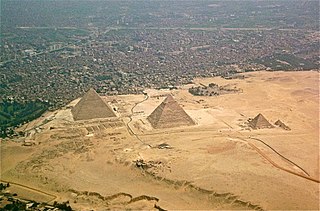
The Giza Plateau is a limestone plateau in Giza, Egypt, the site of the Fourth Dynasty Giza pyramid complex, which includes the pyramids of Khufu, Khafre and Menkaure, the Great Sphinx, several cemeteries, a workers' village and an industrial complex. It forms the northernmost part of the 16,000 ha Pyramid Fields in the Western Desert edge of the Nile Valley that are part of the UNESCO World Heritage Site, Memphis and its Necropolis.

The Layer Pyramid is a ruined step pyramid dating to the 3rd Dynasty of Egypt and located in the necropolis of Zawyet El Aryan. Its ownership is uncertain and may be attributable to pharaoh Khaba. The pyramid architecture, however, is very similar to that of the Buried Pyramid of king Sekhemkhet and for this reason is firmly datable to the 3rd Dynasty.

The pyramid of Neferirkare was built for the Fifth Dynasty pharaoh Neferirkare Kakai in the 25th century BC. It was the tallest structure on the highest site at the necropolis of Abusir, found between Giza and Saqqara, and still towers over the necropolis. The pyramid is also significant because its excavation led to the discovery of the Abusir Papyri.
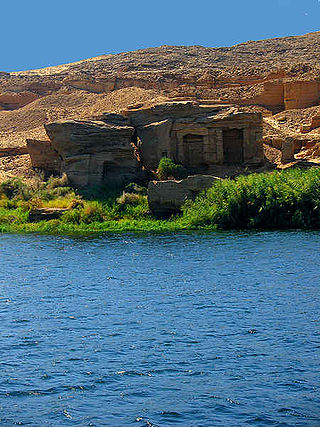
The stone quarries of ancient Egypt once produced quality stone for the building of tombs and temples and for decorative monuments such as sarcophagi, stelae, and statues. These quarries are now recognised archaeological sites. Ancient quarry sites in the Nile valley accounted for much of the limestone and sandstone used as building stone for temples, monuments, and pyramids. Eighty percent of the ancient sites are located in the Nile valley; some of them have disappeared under the waters of Lake Nasser and some others were lost due to modern mining activity.

The pyramid of Senusret I is an Egyptian pyramid built to be the burial place of the Pharaoh Senusret I. The pyramid was built during the Twelfth Dynasty of Egypt at el-Lisht, near the pyramid of his father, Amenemhat I. Its ancient name was Senusret Petei Tawi.

The pyramid of Neferefre, also known as the pyramid of Raneferef, is a 25th century BC unfinished pyramid complex built for the Egyptian pharaoh Neferefre of the Fifth Dynasty. Neferefre's unfinished pyramid is the third and final one built on the Abusir diagonal – a figurative line connecting the Abusir pyramids with Heliopolis – of the necropolis, sited south-west of Neferirkare's pyramid.
Meritites I was an ancient Egyptian queen of the 4th Dynasty. Her name means "Beloved of her Father". Several of her titles are known from a stela found at Giza. She was buried in the middle Queen’s Pyramid in Giza.

The pyramid of Nyuserre is a mid-25th-century BC pyramid complex built for the Egyptian pharaoh Nyuserre Ini of the Fifth Dynasty. During his reign, Nyuserre had the unfinished monuments of his father, Neferirkare Kakai, mother, Khentkaus II, and brother, Neferefre, completed, before commencing work on his personal pyramid complex. He chose a site in the Abusir necropolis between the complexes of Neferirkare and Sahure, which, restrictive in area and terrain, economized the costs of labour and material. Nyuserre was the last king to be entombed in the necropolis; his successors chose to be buried elsewhere. His monument encompasses a main pyramid, a mortuary temple, a valley temple on Abusir Lake, a causeway originally intended for Neferirkare's monument, and a cult pyramid.
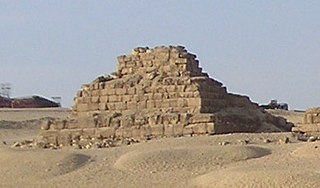
G3-c is one of the three pyramid companions Pyramid of Menkaure. It is located on the south side of the Menkaure pyramid in the Giza Necropolis. It is the westernmost of the three pyramids of the queens.

The pyramid of Khentkaus I or step tomb of Khentkaus I is a Fourth Dynasty two-stepped tomb built for the Queen Mother Khentkaus I in Giza. The tomb, built in two phases coinciding with its two steps, was originally known as the fourth pyramid of Giza. In the first phase, a nearly square block of bedrock, around which the stone had been quarried for the Giza pyramids, was utilised to construct her tomb and encased with fine white Tura limestone. In the second phase, most likely in the Fifth Dynasty, her tomb was enlarged with a large limestone structure built on top of the bedrock block. The Egyptologist Miroslav Verner suggests that this may have been intended to convert her tomb into a pyramid, but was abandoned as a result of stability concerns. South-west of the tomb was a long boat pit, which housed the Night boat of Re. A companion day boat has not been found. A chapel was built into the tomb superstructure, with a large granite entrance bearing the queen's name and titles. One of her titles was of particular interest because it had not been known of prior to its discovery at her tomb.

G3-a is one of the three pyramid companions of the Pyramid of Menkaure. It is located on the south side of the Menkaure pyramid in the Giza Necropolis. It is the easternmost of the three pyramids of the queens. The pyramid was built during the Fourth Dynasty of Egypt, presumably for one of the wives of Menkaure. The American archaeologist George Andrew Reisner was "confident" that the structure housed Khamerernebty II, but this is far from certain.

G3-b is one of the three pyramid companions Pyramid of Menkaure. It is located on the south side of the Menkaure pyramid in the Giza Necropolis. It is the middle of the three pyramids of the queens, and in the structure the body of a woman was discovered. The American archaeologist George Andrew Reisner speculated that the queen buried in the pyramid may have been Menkaure's half-sister, Shepsetkau, the daughter of Meresankh III and Khafre.
